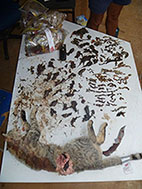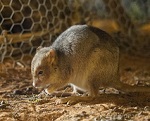Cats in Australia: Ecology, Impact, Management
Feral cats are known to kill many Australian reptiles, but the conservation consequences of such predation have not previously been comprehensively assessed. Here, we aggregated and modelled results from many studies and found that (1) predation by cats on reptiles was highest in arid areas, (2) an average feral cat kills 225 reptiles per year, (3) across Australia, 649 million reptiles are killed by cats annually, (4) this rate of loss is higher than that reported on other continents, and (5) predation by cats has been reported for 258 Australian reptile species including 11 threatened species. These results indicate that predation by cats may be a threat affecting many Australian reptile species.
Because feral cats have been found to hunt extensively in intense fire scars in north-western Australia, we aimed to test the generality of this pattern by measuring cat habitat selection in far north-eastern Australia. Feral cats demonstrated strong selection for recent fire scars, open wetlands, yet avoided rainforests. This suggests that impacts of feral cats can be mitigated by managing fire regimes, and targeting control efforts to their preferred habitats. Photograph by Alex Hartshorne.
Reintroduction is a key management activity to restore mammal species within Australia, but there are few long-term case studies.Western barred bandicoots were reintroduced to an arid coastal site in Western Australia in 1996 to establish the first mainland population in over 60 years. Subsequent establishment and trend were monitored to 2010, revealing the response of the population to key challenges: predation, extreme drought, and loss of shelter to rabbits. The study highlights the difficulties of maintaining management over the long-term for species that require ongoing active intervention, particularly control of exotic predators. Photograph by Jeff Short.
Small mammal often decline in abundance after fire, but how fire causes this change is usually not known. We intensively monitored two species of tropical rodents through experimental burns to show that declines of abundance were caused by increased predation, rather than to other possible effects of fire. Our results suggest that fire management can be used to reduce the impacts of predators on species of small mammals that are currently in decline.
Feral cats threaten biodiversity, and are often culled to reduce their impact. The effectiveness of culling is largely unknown in areas where new cats can replace those removed, but by using remote camera technology to identify individuals, we found that low-level culling resulted in an increase in cat numbers and activity. This unexpected result demonstrates the importance of monitoring management actions, and the need for strategic, systematic, and ongoing commitment to managing feral cats if their impact on biodiversity is to be reduced.
Feral cats (Felis catus) are implicated in the decline of Australian mammals and new research suggests that predation risk from feral cats could be managed by manipulating fire regimes. We investigated the role of fire history in the occurrence of feral cats and rare rodents, including the critically endangered central rock-rat (Zyzomys pedunculatus), in a mountain refuge in central Australia. Our results suggest that fire management could be used as a tool for rodent conservation in arid Australia.
Innovative techniques are required to sustainably reduce the catastrophic effect of cat predation on prey species that are vulnerable to extinction. We propose several novel or modified feral cat control techniques that exploit cats’ innate hunting instincts and their greater susceptibility to certain toxins than native fauna. Creation of toxic cat prey could improve the sustainability and cost-effectiveness, whilst minimising non-target risks, of cat control programs.
Predator-free islands and fenced exclosures have helped prevent extinction in Australian mammal species that are preyed upon by introduced cats and European red foxes. In a ‘stocktake’ of these ‘havens’, we identified 118 islands and fenced areas, covering 2490 km2, that protect 188 populations of 38 predator-susceptible mammal taxa. Some predator-susceptible taxa are in multiple havens, but many (43%) are not represented anywhere within the existing haven network, and future investment in havens should favour taxa with no (or low) existing representation.









